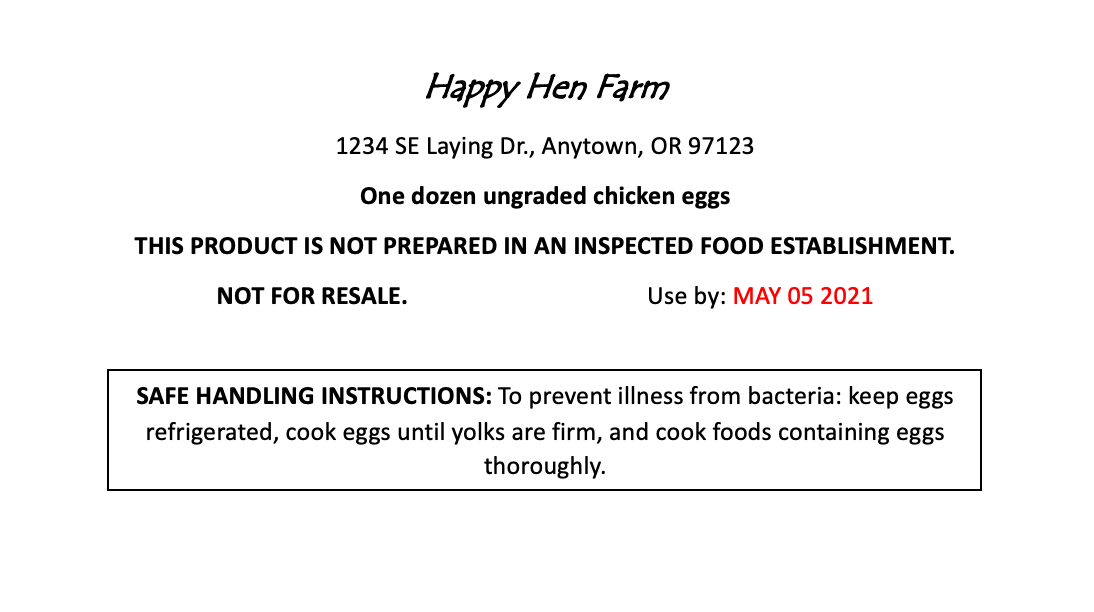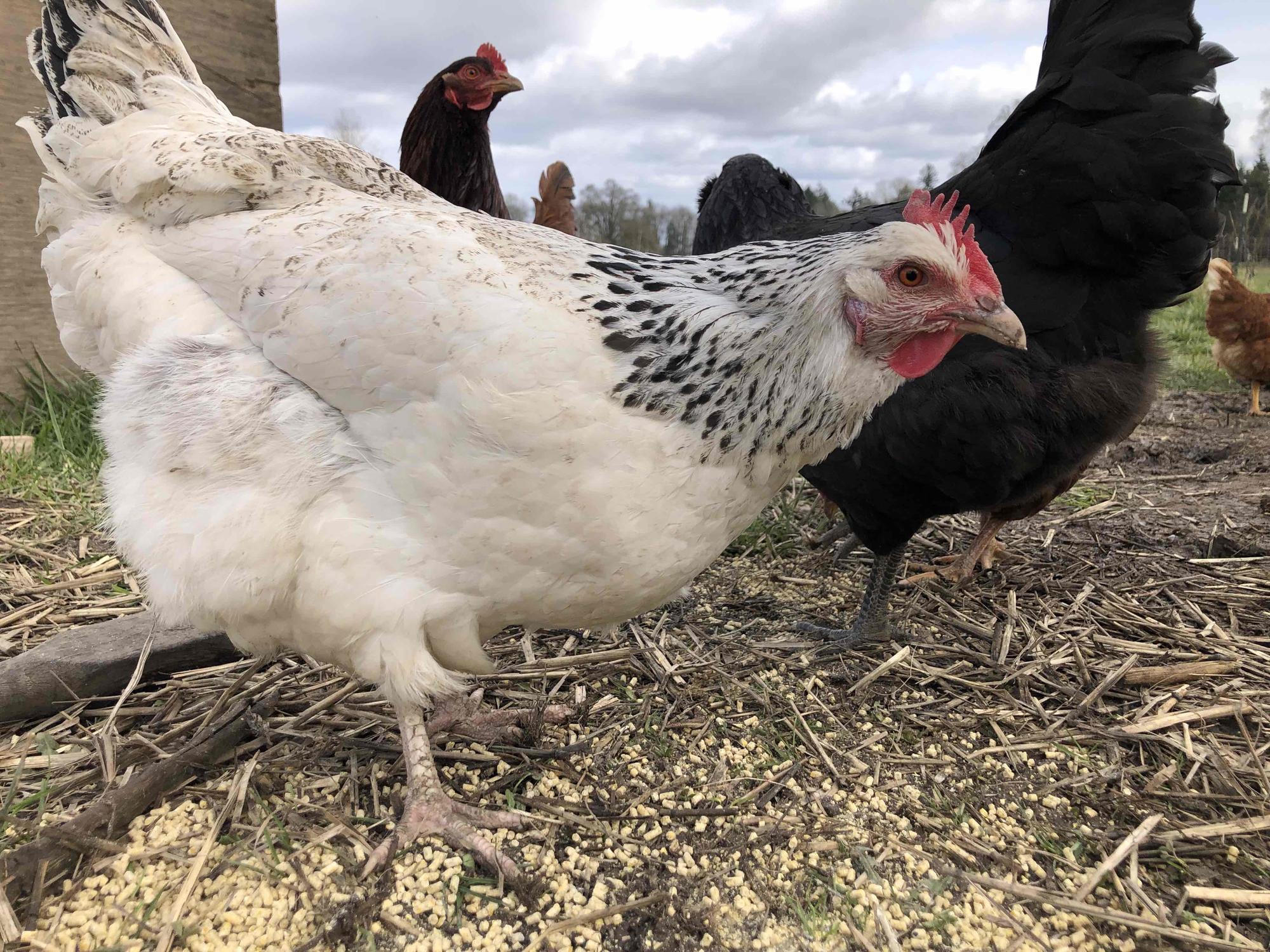Oregon's Farm Direct Marketing law exempts producers who sell agricultural products that they themselves grow from state licensing.
Do you produce and sell eggs directly to consumers? If so, there are specific labeling and handling requirements that you need to follow to qualify for the farm-direct licensing exemption and stay legal.
This publication outlines these requirements and provides guidance on how to sell high-quality eggs to your customers. It is important to remember that although you may qualify for a license exemption, you are not exempt from following food safety guidelines.
Your business does not qualify for the farm-direct exemption and you will need an egg handler’s license if you are:
- Selling eggs to wholesale accounts such as restaurants, retailers, cafes, bakeries, hospitals, schools, boarding houses or institutions.
- Selling eggs that you did not produce.
To obtain an egg handler license, contact the Oregon Department of Agriculture Food Safety Division through its website or call 503-986-4720.
Labeling requirements
You must label your egg cartons with the following information:
- Your farm or personal name and farm address.
- Product identity (chicken eggs, duck eggs, etc.).
- Net contents (for example, one dozen ungraded eggs or one dozen large AA eggs). Note that farm-direct eggs may be sold ungraded. To sell eggs with size and grade (such as large AA), you must follow the protocol listed in Oregon Egg Standards.
Please note that eggs must be AA or A grade to be labeled as “fresh eggs,” “farm eggs” or “ranch eggs.”
- Safe handling instructions must appear prominently on the outer carton or inside lid and must be no less than one-sixteenth inch in height. In an outlined text box, “SAFE HANDLING INSTRUCTIONS” must appear in boldface type along with the statement “To prevent illness from bacteria: keep eggs refrigerated, cook eggs until yolks are firm, and cook foods containing eggs thoroughly.” If the statement is placed inside the lid, the words “keep refrigerated” must appear on the outer carton. See sample label.
- The following statements must also appear on the label in all-capital boldface type, no less than one-eighth inch in height:
- “THIS PRODUCT IS NOT PREPARED IN AN INSPECTED FOOD ESTABLISHMENT.”
- “NOT FOR RESALE.”
Use-by and sell-by dates
State law requires eggs to have either “use by” or “sell by” dates clearly visible to consumers. The USDA recommends that the sell-by date be no more than 30 days after production and the use-by date be no more than 45 days after production. Producers selling directly to consumers typically use a use-by date, which indicates the maximum time period consumers can expect eggs to maintain quality when properly stored. The date can be handwritten or stamped. Date stamps can be purchased from a variety of sources.
Cartons
If you package your eggs in previously used cartons, all identifying information from the previous seller must be removed or defaced.
This includes the brand, trademark, officially designated number of another egg handler and the use-by or sell-by date.
If you use recycled cartons, make sure they are clean and stored in a sanitary environment between uses. The use of new cartons is encouraged. Cartons can be purchased in bulk to save you time and money.
Cleaning and refrigeration
Wash hands thoroughly while handling eggs. Keep nest boxes clean and collect eggs at least once per day. Collect eggs twice a day to reduce the chance of dirty and broken eggs. Ensure eggs are cleaned and refrigerated soon after collection. This helps limit the chance of contamination and loss of interior quality.
Egg must be visibly clean. Some eggs may not need to be cleaned at all, but if they are not visibly clean, they can be dry cleaned or wet washed, sanitized and dried.
You may use fine sandpaper to remove stains and dirt from dry shells.
If you are washing eggs, the water must be 20°F higher than the temperature of the egg being washed. Examples of washing include using spray bottles or briefly rinsing the eggs under running water. Following washing, eggs must be spray-rinsed using an approved sanitizer and dried.
Eggs must remain refrigerated and dry after cleaning and until they are sold. Coolers with ice packs are an acceptable form of refrigeration during transportation and selling of eggs if you can maintain a temperature at or below 45°F. We suggest using a thermometer for monitoring.
All eggs must be:
- Kept at or below 45°F promptly after gathering.
- Refrigerated during transportation.
- Refrigerated and stored at or below 45°F at the point of sale, including:
- Farmers markets.
- CSA pick-up sites.
- Farm stands.
Eggs used for display that are not kept at or below 45°F cannot be sold.
WAIT!
Do I need to refrigerate my eggs at the farmers market if I collected them that morning?
YES! All eggs must be refrigerated at the point of sale.
Maintaining food safety and egg quality
Preventing temperature fluctuation is critical to food safety. Never cool eggs rapidly before they are cleaned. The egg contents may contract and pull bacteria such as E. coli and Salmonella from the surface into the shell pores.
Before washing eggs, allow them to reach room temperature (about 70°F). Try to keep the temperature relatively constant until they are washed. Before refrigeration, wash eggs with potable water that is 20°F warmer than the eggs. Washing with cold water may also cause the contents to contract, drawing surface bacteria into the shell.
After eggs are refrigerated, they need to stay at or below 45oF. A cold egg left out at room temperature can condense water on the shell (sweat), facilitating the movement of bacteria into the egg and increasing the growth of bacteria.
Eggs that are cracked or inedible should not be sold.
Farm-direct sales require a process known as candling. Candling helps determine the interior quality of shell eggs using bright light. Commercial candling lights are available, or you can use a high-intensity flashlight in a darkened room. Candling can reveal air cell depth; yolk and albumen condition; white and egg yolk quality; and blood or meat spots. Eggs showing blood rings, eggs containing embryo chicks (at or beyond blood ring state) and other examples of inedible eggs as defined by the Oregon egg standards are not allowed to be sold.
Questions?
Contact your local Oregon Department of Agriculture inspector. To find an inspector, search for a food safety specialist by ZIP code.
Oregon State University Extension Service has knowledgeable staff across the state. You can easily submit a question to Ask Extension.
Resources
Oregon egg standards, OAR 603, provide the state requirements to handling and selling eggs.
Oregon’s Farm Direct Marketing law allows for licensing exemptions for some locally grown, raised and processed products. See Oregon Department of Agriculture’s publication “Farm Direct Marketing, Agricultural Products” for more information.
The USDA publication “Shell Eggs from Farm to Table” provides more information about safe food handling
Sanitizing eggs after washing is required in Oregon. See ATTRA’s FAQ on How Should I Sanitize My Farm Fresh Eggs for details.
Washing and refrigerating eggs is required if you are selling them in the United States. The USDA explains why.










